In 2006 I spoke at a conference in Budapest. At the time, there was a bunch of fascists protesting in the town square, and it was getting international news coverage.
The fascists, from most angles, looked like a bunch of bored deplorables having a barbecue. Everyone walked around them and mostly ignored them except for the CNN camera crews that would sneak in and get low-angle shots with telephoto lenses to make the little cluster of ultra-nationalists look much bigger than they were. As I walked by, they set fire to some paper (conveniently pulled out of a garbage bin) for the camera crew.

mjr, 2006
I asked one of the passers-by what was going on and they said “playing for the camera” – about as good a thumbnail sketch as you’ll ever get.
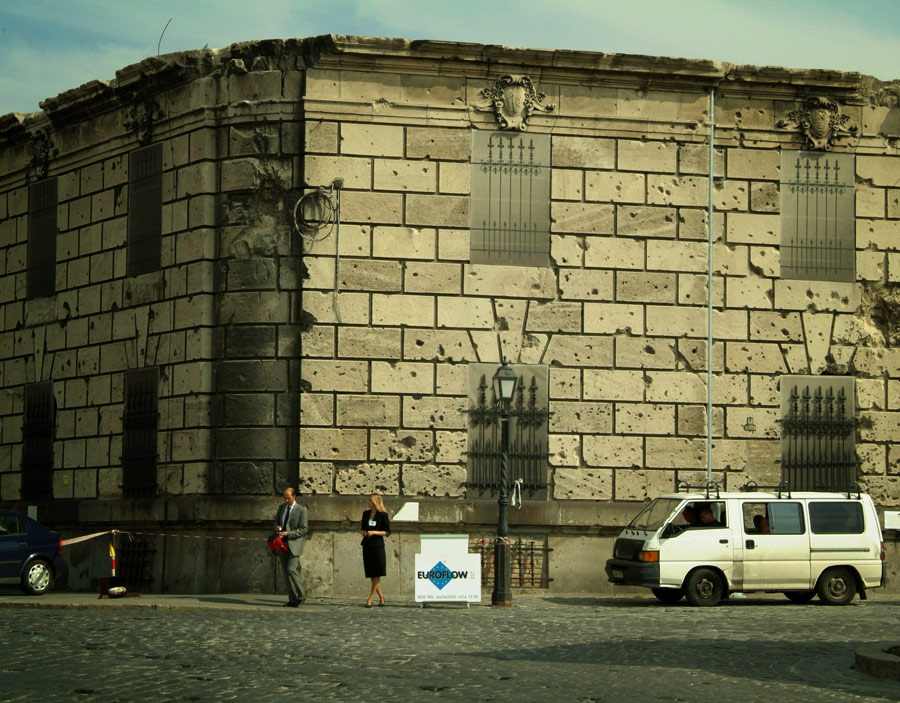
mjr. 2006
I don’t know what this building is, but it sports a common feature of the European landscape: high explosive damage. Fragmentation shells going off near stone – that’s what that damage is. Bullets make small chips, artillery makes splashes. It’s not notable in much of Europe because when you’re talking about buildings that have survived centuries of warfare, they’re either damaged or they’re gone. Or they’re new.
One of the most embarrassing verbal faux pas I ever made was in a taxi from the airport on my first trip into Koln. I remarked to the driver “I love all this modern architecture” and he replied, “we had to renovate a lot after 1945.” I said, “that’s one of the dumbest things I’ve ever said” and slouched into silence for the rest of the drive, and watched all the modern architecture go by. As I have mentioned elsewhere, ultra-nationalism, in the 20th century, [stderr] seems to result in having your cities flattened.
I was there as a speaker for a security conference, naturally, so the folks who had invited me (the makers of the widely popular syslog-ng) took me out for a lot of food and beer and then Unicum – an “alcohol-soaked herbal concoction” that acted on me like syrup of ipecac. It was a good time. The next afternoon, after the conference and before alcohol o’clock, they took me museuming – specifically to the military museum, so I could drool over the hussars’ uniforms and photograph cavalry tack and saddles for my saddle-maker acquaintances. That done, we went to the Memorial Park.
The Hungarians had a problem that should seem familiar to Americans: they had a lot of old Soviet-era colossal statuary that had been emplaced all over their cities. What do to with all the bronze? There were discussions, naturally. There were all the usual arguments, including one I am sympathetic to: “some artist worked hard on that.” So the Hungarians located a nice field outside of town, and hauled them all there, then left them to weather, and the memories and grass to grow.
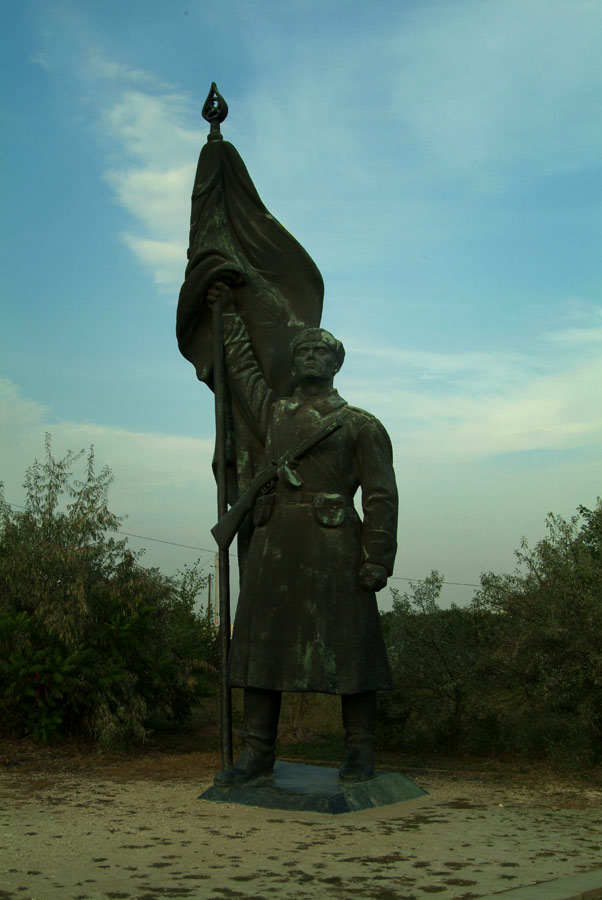
mjr, 2006
The Soviet trooper, in characteristic Red Army gear and carrying an unusually small ppsh-9mm submachine-gun, was probably not a super popular sight in Hungary. Especially not after the uprising. The statue was a statue commemorating liberation from one boot on your neck to another. Just like many of the American civil war statues that still dot the US landscape.

mjr, 2006
I kind of like that one. The allegory is as subtle as a placard. I don’t know the title but it’s probably something like “The New Soviet Worker Has Unstoppable Head-Butt +40 Powers”
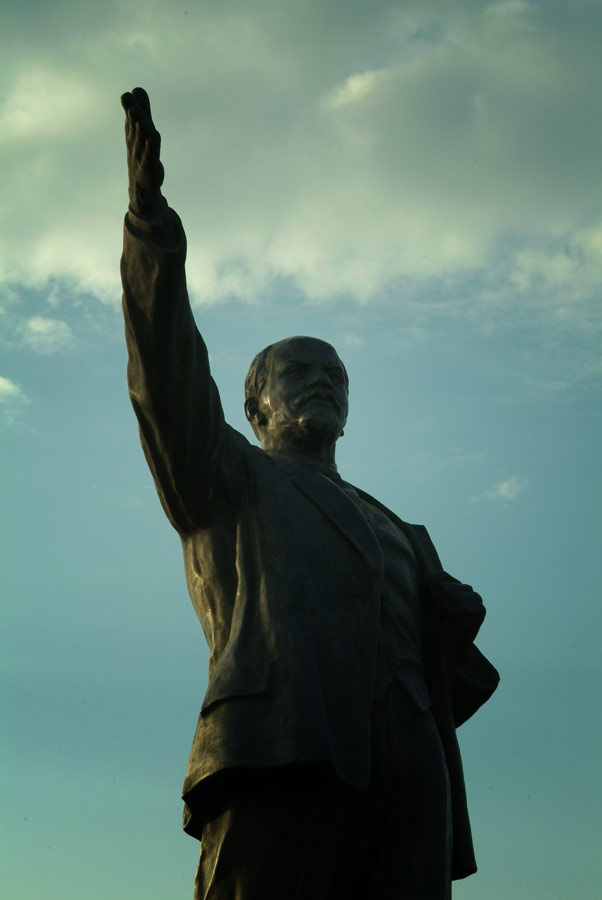
mjr, 2006
“I give you the future!” A future dragged into a field in the middle of no place. Lenin was another ideologue, he was just trying to Make the Workers’ Paradise Great Again. The difference between these ideologues and people who make the world better is that the people who make the world better usually can explain why we should do what they suggest, and it works. Lenin certainly had a lot of ideas.
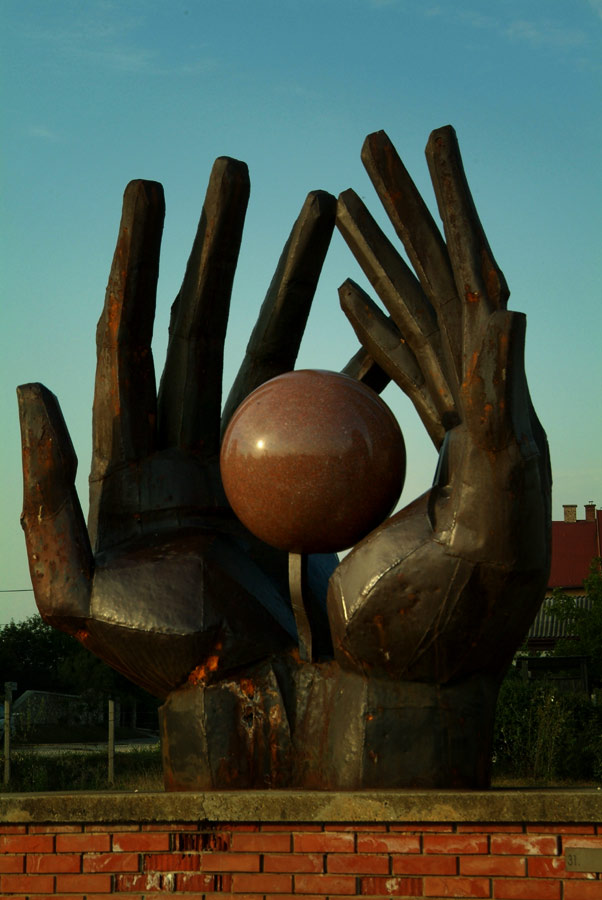
mjr 2006
Some artist worked hard on that.
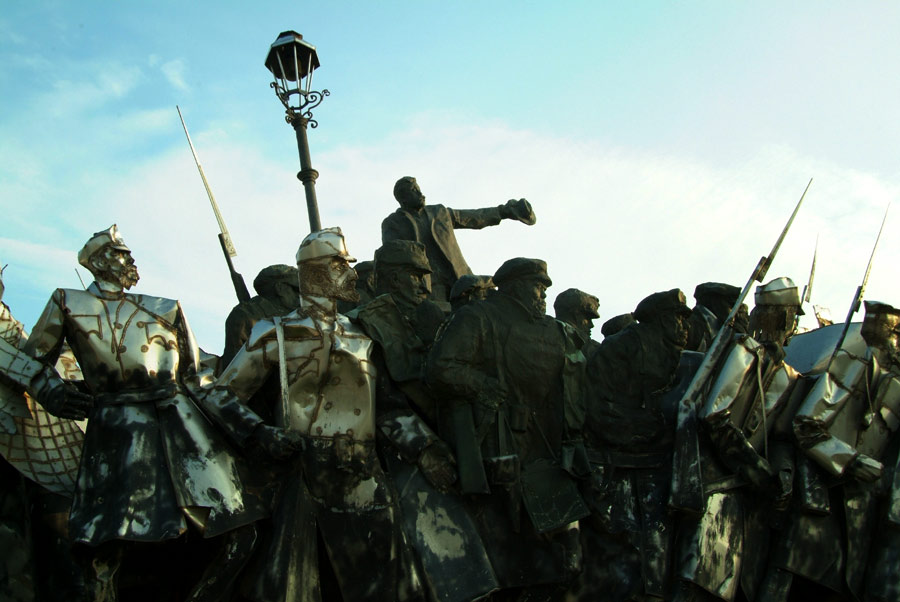
mjr, 2006
Some artist worked hard on that!
It looks to me like they ran out of bronze, or patience, halfway through and started doing spatter-welded stainless steel cut-outs instead. Whatever the artistic effect was, it doesn’t work for me.
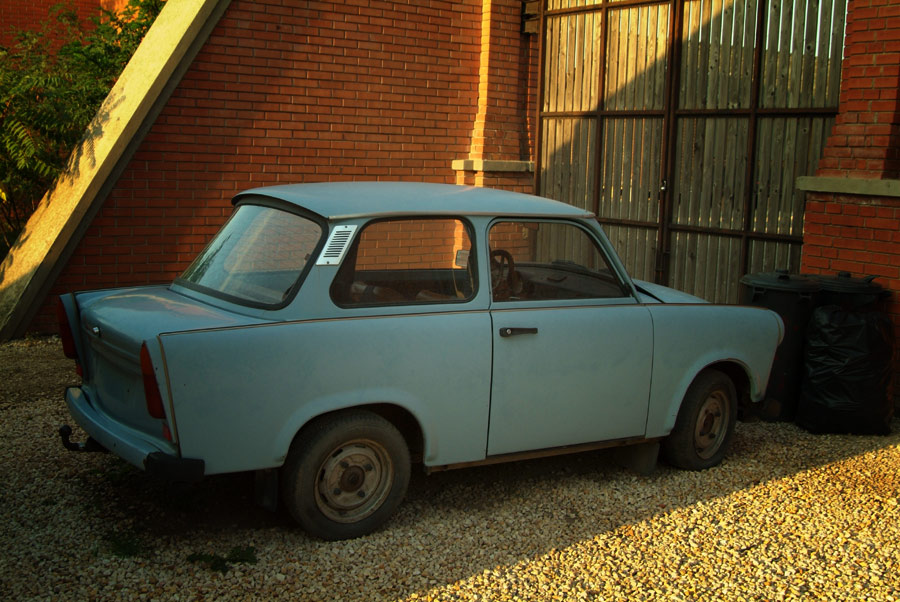
mjr, 2006
Parked by the gate near the exit, is a Trabant. Or is it a Lada? I don’t know how to tell. Someone clearly cares about it enough to keep the tires inflated. It makes me wonder if there is a secret society dedicated to Making Trabants Great Again that periodically comes and inflates the tires. Or, perhaps they are filled with concrete. Perhaps they were always filled with concrete.
These statues (including the Trabant!) are the cultural impositions of a victorious occupying power. It was entirely reasonable for the Hungarians to want them gone, after they were given a chance to re-express their own culture. What Americans don’t seem to be able to track is that the confederate civil war statues are also the cultural impositions of a victorious occupying power. Southern white supremacists lost the civil war but won the post-war reconstruction.

I immediately set out for some W.E.B Du Bois half way through Wolff’s anti-racist autobiography and ho boy the sheer volume of bullshit Americans have been fed about the reconstruction is astonishing. Contrast the Nazis, who underwent a complete ideological purge and to this day cannot use their old symbols in Germany. By comparison, Confederates, somehow, got to write the history books.
I think the example of Hungary and its Soviet-era statuary is a little different from what America currently faces. The Soviet-style statuary was obviously and starkly an imposition from outside – it was in a radically different artistic style from the sort of public sculpture Hungarians had been used to for centuries. It was consciously new and different, and intended to shock Hungarians into compliance with its boldness. The US Confederate statuary (apart from that remarkable cartoon grotesque of Nathan Bedford Forrest) is very much within the tradition of classical statuary that America is used to. It was intended to fit right in, and subtly alter the consciousness of Americans by normalising the characters of the pro-slavery party. It was meant to go under the radar.
I am reminded of one particular incident in Roman history that also casts some light on the treatment of politically embarrassing statues. Towards the end of the Second Century BC, upon her death, the Romans erected a statue in honour of Cornelia Africana in the forum. Cornelia was the revered matriarch of one of Rome’s most influential political dynasties – her father was Scipio Africanus, who had defeated Hannibal, her husband was one of his leading commanders and aides, and her sons were Tiberius and Gaius Gracchus – the reforming tribunes who first stood up to promote land reform and popular political reform in response to the growing power of the landowners and the traditional elites. She was also the centre of a vibrant cultural and intellectual circle, including Greek philosophers and Egyptian and Pergamene royalty. She became the very image of the accomplished Roman noblewoman, although with Roman attitudes toward women being what they were her intellectual accomplishments were largely ignored and the praise came for having raised and educated her two sons so well after the early death of their father – in morals particularly. So it was as “Cornelia, Mother of the Gracchi” that her statue was dedicated.
The problem is that a century and a half later, under the Principate, the Gracchi had become very suspicious figures indeed. Imperial historians such as Livy tended to see their tumultuous political agitations as the beginning of the troubles that saw the fall of the Republic and the beginning of the awful period of civil wars. Cornelia’s generation were seen as the last great Imperial conquerors, under whom Rome’s power reached its height, and her sons were cast as troublemakers and rabble-rousers who destabilised the senatorial system (and collaborated with foreign powers too – all those suspicious Egyptian and Pergamene dignitaries who frequented the household must have been up to something!). So the base of the statue was simple]y re-carved with a new dedication, “Cornelia, Daughter of Africanus”, and her associations with her children minimised. In fact, there exists a letter allegedly written from Cornelia to her son Gaius, pleading with him not to pursue the same political goals that got his brother killed. It is widely considered to be a later forgery, intended to rehabilitate the great matron from these entanglements. By the time Juvenal was writing in the late first century AD Cornelia had been reduced to a caricature of matronly uprightness and propriety – a prim and proper goody-two-shoes who did everything by the book, and was thus irredeemably dull and boring.
Much the same attempt at rehabilitation seems to be going on around the confederate statues. Their supporters are trying to position confederate generals not as supporters of the politically untenable slavery issue but as much more upright and constitutionally-minded figures whose main interest was in preserving the independence of the states. Daughters of the Constitution, rather than Mothers of Oppression if you will.
cartomancer@#2:
I think the example of Hungary and its Soviet-era statuary is a little different from what America currently faces. The Soviet-style statuary was obviously and starkly an imposition from outside – it was in a radically different artistic style from the sort of public sculpture Hungarians had been used to for centuries. It was consciously new and different, and intended to shock Hungarians into compliance with its boldness. The US Confederate statuary (apart from that remarkable cartoon grotesque of Nathan Bedford Forrest) is very much within the tradition of classical statuary that America is used to. It was intended to fit right in, and subtly alter the consciousness of Americans by normalising the characters of the pro-slavery party. It was meant to go under the radar.
Yes, that was all part and parcel of the mask-wearing, night-crawling white insurgency. The thing I think that we need to remember is that, for a significant percentage of the southern American population, those statues are an imposition from the outside. It’s a continuance of imposition “we’re down, but not defeated” and “the south will rise again” – those messages are as clear as a burning cross on someone’s lawn.
She became the very image of the accomplished Roman noblewoman, although with Roman attitudes toward women being what they were her intellectual accomplishments were largely ignored and the praise came for having raised and educated her two sons so well after the early death of their father – in morals particularly. So it was as “Cornelia, Mother of the Gracchi” that her statue was dedicated.
The Gracchi from the same family as the Scipios? I did not know that!
I wonder who proposed the statue in the first place… It wouldn’t have been one of her descendants, by any chance? (It seems that’s usually where the public appreciation flows from)
Much the same attempt at rehabilitation seems to be going on around the confederate statues. Their supporters are trying to position confederate generals not as supporters of the politically untenable slavery issue but as much more upright and constitutionally-minded figures whose main interest was in preserving the independence of the states. Daughters of the Constitution, rather than Mothers of Oppression if you will.
Yes, over on farcebook, I have encountered several people who have already insisted that Lee was a great general (he was meh, at best) and didn’t own slaves (actually, he did and was horrible to them)
There is a theory that the statue on this base wasn’t originally supposed to be Cornelia at all, but was a generic Greek goddess statue repurposed in Augustan times to commemorate her (perhaps as a parallel for Augustus’s sister Octavia, and at any rate as part of Augustus’s programme of moral reform that stressed marriage, duty and familial piety). If it was Cornelia from the beginning then it is entirely likely that one of her descendants had it put up, or a consortium of the family’s clients and political allies.
All the big families in Rome tended to be related to one another in some way. Cornelia’s great-granddaughter Fulvia (whose mother was one of the Crassus family) was married to both Publius Clodius (Cicero’s great rival) and later to Mark Antony.
I just found out today that apparently Cornelia does have a small American civil war connection too. The state-house of Ohio has apparently got a statue of Cornelia in its grounds, representing the state, with the famous maxim attributed to her (“these are my jewels” – i.e. my children are more valuable to me than riches) referring to smaller statues of the Union generals and politicians who fought for the state in the civil war.
Yes, it is,
And, yes, the tires came from the factory filled with Soviet concrete.
Raucous Indignation @ 6
Heh. The in German Wikipedia the page about Formel Easter (the single seater racing series of the East Block) states that the Czech Barum tyres they used early on were so hard that they could be used multiple seasons (as opposed to changed once, twice or more/race as in Formula 1).
Ice Swimmer @ 7
Well those are ridiculous looking “race cars.” I watched that race. Rock hard, durable tires should be on industrial equipment, not race cars. The cars were sliding all over the place, and not in a good way. I think my current road car would be competitive against that field. It’s certainly NOT Group C.
Raucous Indignation@#6:
And, yes, the tires came from the factory filled with Soviet concrete.
Are you kidding?
Some of the farmers out here fill their tractor tires with plaster, to make them heavier and less prone to going flat, but I don’t think they have to worry about “smooth ride” and pavement wear.
Marcus@#9 I may not be kidding. The steering on a Trabant is very heavy and yet also vague. It certainly felt like the tires were filled with concrete. Heavy, plodding, leaden, sub-standard bureaucratic Soviet concrete. Or thereabouts.
I’m probably kidding. Pretty sure.